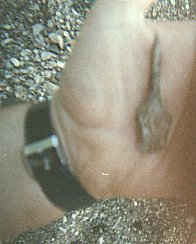WHERE AND HOW TO LOOK
![]()
There are a few ways to go about starting up
your own collection. You can purchase them from local flea
markets, other collectors, or you can choose to go out and find them yourself. I
prefer the latter, its the thrill of the searching that gets
to me. There is no better feeling than to find a point laying
on the ground, untouched for all of these centuries. It is history, it is art. Its something special created by skilled
hands from the past. They arent "rocks" they were a means of
providing food and sometimes protection. If you do decide
to get your hands dirty, and enjoy the rewards of finding them
yourself, you need to know where to start. First thing, imagine
what we all need to survive...food, water, and protection from the
elements. I have found in my area, that when i find a large
hill, mountain, or bluff with water close by you can always
find signs of civilization there. Water is a necessity, and along
creeks, rivers, and lakes is a wonderful place to look. Once you
have the water, search for the protection...a hill, bluff, or any
outcropping, something that would protect them from the wind, rain, and snow. Once you know what you are looking for, site
spotting becomes much simpler. Let me show you a picture of
my favorite spot on lake hudson to look. At least 95% of all of my finds have came from this spot. It is beautiful and surrounded by large hills. This is my arrowhead hunting buddy
eddard, fishing at my favorite spot on northern lake hudson, mayes
co. oklahoma.
Once you have deemed a place capable of ancient civilizations dwelling there, you need to know precisely where and how to look. Remember that these rocks have been laying around for hundreds, and thousands of years, buried by
mother earth, so the most logical place to look, is where the
earth is being eroded, and washed away. Washouts and gullies,
where the rain drains off, is a very good place to look. First, look
for the type of rock in the area. Flint and chert (a low grade flint) was the material of choice in this general area.
The indians often heat treated their rock to make it easier to
work. This changes the molecular structure, and sometimes color
of the stone, so if you see bright colorful stone, you know you
are in the right place. Flake debris, commonly called "chips" are
a dead giveaway of flintknapping. Chips are the razor sharp flakes that are struck from the stone while forming a point. Plowed fields are also another good place to look for signs of
ancient human habitation, but the plow breaks up many of the
points, and its harder to find things complete. Again, look
for a source of water first. I find most of my artifacts at the
edge of water, or in the water. I never dig, surface finds only. Please remember to check your state and local laws before you go gallavanting around. The picture below is of a drill in my
hand, right after i picked it up.
I love the excitement
of finding a nice arrowhead. It puts alot of questions in my
head, who made it, why, etc. Maybe we should all take more of
an interest in past cultures, they made us what we are today. Lastly, if you choose to buy your artifacts, be very careful
of forgeries, there are many out there. Flintknapping is quite a
skill, i do some of it myself. There are a few ways to tell
fakes from the real deal. Firstly is patina, a coating developed
from oxidation. If you take a rock that has been laying around
for centuries, chip off a little piece of it, the inside is a different color, the patina changes the appearance over the years. Another thing to look for is sharpness. The edges will
be a little duller than when origanlly made, wear and tear, and time does that. If you go somewhere and see a display case full of
perfect 10" dovetails made of the same rock and looking identical, they are most likely forgeries. Some flintknappers nowadays actually try to put a patina on the stone, and make them look authentic as possible. Be careful, make sure you get authentification in writing. If the seller is upstanding he will understand and will gladly oblige. There are more forgeries
out there than there are real items and people will do anything
to make a buck. If you dont like to take chances, you want to know where it came from, do like me, put on your boots, and go
have fun experiencing finding them for yourself, you wont regret it.
Common points